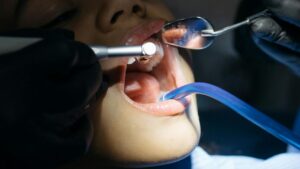Toothaches and infections can strike at the worst times—and while over-the-counter painkillers may offer relief, many turn to natural remedies for quick and effective solutions. One such time-tested remedy is garlic. Yes, the humble kitchen staple is not just for flavor—garlic for tooth pain and garlic for tooth infection has been used for centuries due to its powerful antibacterial and anti-inflammatory properties.
According to studies cited by WebMD, garlic contains allicin, a compound that actively fights infection-causing bacteria. When used properly, garlic can offer temporary relief from toothache, abscesses, and even minor decay-related discomfort.
✅ Note: While garlic can provide relief, it should not replace professional dental treatment—especially in the case of serious infections.
🦷 Why Garlic Works for Tooth Issues
Garlic is more than a seasoning—it’s a natural antimicrobial agent. The active compound allicin is released when garlic is crushed or chopped. Allicin has been shown to:
- Kill bacteria like Streptococcus mutans, often linked to dental cavities
- Reduce inflammation around infected or abscessed teeth
- Soothe pain by numbing nerves and reducing swelling
Scientifically Supported Benefits:
- Antibacterial – Helps reduce harmful oral bacteria
- Anti-inflammatory – Eases gum swelling and irritation
- Analgesic – Provides a numbing effect for pain relief
📌 Note: Garlic is not a cure but a helpful temporary solution until you can see your dentist.
Additional Nutritional Support
Besides allicin, garlic also contains:
- Vitamin C – Supports gum health
- Selenium – Aids tissue repair
- Manganese & Calcium – Strengthen teeth and bones
These nutrients can support your body’s immune response and healing process.
🦷 Common Dental Issues Garlic Can Help With
Using garlic for toothache or infection isn’t just an old wives’ tale—it’s backed by centuries of use and some emerging scientific support. Here’s how it may help in different cases:
1. Garlic for Tooth Pain Relief
If you’re dealing with a sudden, sharp toothache:
- Garlic may dull the pain by numbing the affected nerve endings.
- It also reduces bacterial activity in the infected area.
- Crushed garlic acts faster due to direct allicin contact with the tooth.
2. Garlic for Tooth Infection
Mild infections or abscesses can benefit from garlic’s antibacterial properties:
- It reduces swelling and redness.
- Helps prevent bacterial growth before professional care is available.
- Can be used in combination with warm saltwater rinses.
3. Garlic for Tooth Abscess
Abscesses are pockets of pus caused by bacterial infections:
- Garlic can temporarily reduce swelling.
- It may help reduce pus formation in early stages.
- Never rely solely on garlic for abscess; always seek dental help.
4. Garlic for Tooth Decay
Garlic may reduce bacterial populations that contribute to decay:
- Helps keep the mouth’s microbiome balanced.
- May slow down the progress of early cavities.
- Combine garlic with good oral hygiene habits.
🔍 How to Use Garlic for Tooth Pain and Infection
Method 1: Crushed Garlic Clove (Most Effective)
- Take a fresh clove of garlic.
- Crush it to release the allicin.
- Apply the crushed garlic directly to the aching or infected tooth.
- Leave it for 5–10 minutes and then rinse your mouth with warm saltwater.
Tip: Add a pinch of sea salt to enhance its antibacterial effect.
Method 2: Chewing Garlic for Tooth Infection
- Chew a peeled garlic clove on the side of your mouth with pain.
- Saliva helps activate allicin and spread its effects.
- Do this once or twice a day, but monitor for irritation.
Note: Discontinue if gums become red or sore.
Method 3: Minced Garlic Paste
- Mix minced garlic with a little salt.
- Apply to the affected area for 10 minutes.
- Rinse with warm water.
This method is gentler than chewing and easy to apply precisely.
Method 4: Garlic Oil Rinse
- Dilute garlic oil in warm water (1 drop in 1 tbsp water).
- Swish around mouth for 30 seconds.
- Spit out—do not swallow.
Important: Always use food-grade garlic oil.
Method 5: Garlic & Clove Oil Combo
- Mix 1 drop of clove oil and crushed garlic.
- Apply with cotton to the painful tooth.
- Clove enhances numbing while garlic disinfects.
⚠️ Precautions When Using Garlic on Teeth
Although garlic is generally safe, misuse can cause side effects:
- Burning sensation on gums
- Irritation or allergic reactions
- Bad breath due to sulfur compounds
Tips for Safe Use:
- Do not leave garlic on the tooth for too long.
- Never use garlic on open wounds without dental advice.
- Always consult a dentist for persistent pain.
- Use garlic only in its fresh, raw form for maximum benefit.
Warning: Do not use garlic as a substitute for root canal treatment, abscess drainage, or tooth extraction.
📅 When to See a Dentist
Garlic offers short-term relief, but persistent symptoms mean it’s time for a professional. Visit a dentist if you experience:
- Fever along with a toothache
- Severe swelling or pus discharge
- Pain lasting more than 48 hours
- Difficulty opening your mouth
- Swollen lymph nodes or face
Garlic Is a First Aid Tool, Not a Final Treatment
Even holistic dental practitioners recommend garlic only as a temporary solution. Dental infections, if left untreated, can lead to serious complications like:
- Bone loss
- Systemic infections
- Tooth loss
Frequently Asked Questions
How do I use garlic for tooth pain?
Crush a fresh garlic clove and apply it directly to the affected tooth for 5–10 minutes, then rinse with warm saltwater.
Can garlic cure a tooth infection?
Garlic may help reduce bacteria and inflammation temporarily, but it is not a cure. Dental treatment is still necessary.
Is chewing garlic good for toothache?
Yes, chewing garlic can release allicin that may reduce pain and fight bacteria, but it may irritate the gums if overused.
How effective is garlic for a tooth abscess?
Garlic can ease swelling and discomfort, but it cannot replace medical drainage or antibiotics required for abscess treatment.
How often can I use garlic on my tooth?
Once or twice daily for up to two days is generally safe. Prolonged use may cause gum irritation or burning.
📜 Final Thoughts
Using garlic for tooth pain and garlic for tooth infection is a convenient and natural remedy that can offer real relief—especially when you need a quick fix at home. From chewing garlic for tooth infection to applying minced garlic for tooth pain, there are several effective methods to try.
Still, as experts from the American Dental Association emphasize, natural remedies should support—not replace—standard dental care. For lasting solutions, proper oral hygiene and regular dental checkups are essential.
Takeaway Summary:
- Garlic is rich in allicin, which has antimicrobial and anti-inflammatory effects.
- It can help reduce pain, swelling, and bacterial load temporarily.
- Safe methods include crushed garlic, garlic paste, and garlic oil rinse.
- Not a substitute for antibiotics or dental procedures.
Always prioritize your oral health with regular cleanings, brushing twice a day, and using dentist-approved treatments.
Disclaimer: The content provided in this article is for educational and informational purposes only. It does not substitute professional medical advice, diagnosis, or treatment. For guidance specific to your dental condition or recovery, please consult your dentist, oral surgeon, or licensed healthcare provider.










0 Comments